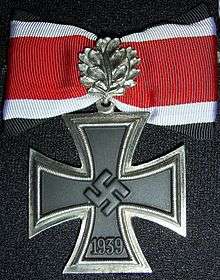Engelbert Endrass
| Engelbert Endrass | |
|---|---|
 Endrass (foreground) and crew members, 1940 | |
| Born |
2 March 1911 Bamberg |
| Died |
21 December 1941 (aged 30) Northeast of Azores 44°02′N 20°10′W / 44.033°N 20.167°W |
| Allegiance |
|
| Service/branch |
|
| Years of service | 1935–41 |
| Rank | Kapitänleutnant |
| Unit | 7th U-boat Flotilla |
| Commands held |
U-46 U-567 |
| Awards | Knight's Cross with Oak Leaves |
Engelbert Endrass (German: Engelbert Endraß) (2 March 1911 – 21 December 1941) was a German U-boat commander in World War II. He commanded the Type VIIB U-boat U-46 and the Type VIIC U-567, being credited in Nazi propaganda with sinking twenty-two ships on ten patrols, for a total of 118,528 gross register tons (GRT) of Allied shipping, to purpotedly become the 23rd highest scoring U-boat commanders of World War II. He was a recipient of the Knight's Cross of the Iron Cross with Oak Leaves of Nazi Germany. It was Germany's highest military decoration at the time of its presentation to Endrass.
Career

Endrass began his naval career in April 1935. After some months on the cruiser Deutschland and service on escort ships, he was assigned in October 1937 to the U-boat force. He joined U-47 in December 1938 as Leutnant zur See. He was first Watch Officer when Günther Prien made his famous Scapa Flow attack and sank HMS Royal Oak. The famous snorting bull emblem on U-47's conning tower was painted by Endrass before they returned.[1]
Endrass remained on U-47 until December 1939, when he left the U-boat and after some training courses took over command of U-46 in May 1940 from the relatively unsuccessful Herbert Sohler, who had only sunk two ships in five patrols. Endrass had immediate success and sank five ships, including the British auxiliary cruiser HMS Carinthia.[1]
Endrass' success continued on his second patrol with U-46, sinking five more ships, including another British auxiliary cruiser, HMS Dunvegan Castle although the main periscope was damaged. After returning from this patrol, Endrass received the Knight's Cross of the Iron Cross. Five patrols later he received the Oak Leaves to his Knight's Cross.[1] The presentation was made on 30 June 1941 by Hitler at the Führer Headquarter Wolfsschanze (Wolf's Lair) in Rastenburg (now Kętrzyn in Poland).
In September 1941 Endrass left U-46, which would become a training vessel, and a month later took over U-567. On his second patrol, he was killed on 21 December 1941 while operating against Convoy HG 76, when U-567 was sunk with all hands by depth charges from the British sloop HMS Deptford and corvette HMS Samphire, northeast of the Azores.[1]
Awards
- Wehrmacht Long Service Award 4th Class (5 April 1939)[2]
- Spanish Cross (6 June 1939)[2]
- Iron Cross (1939) 2nd Class (25 September 1939) & 1st Class (17 October 1939)[2]
- U-boat War Badge (1939) (19 December 1939); with Diamonds (18 July 1941)[3]
- Italian Croce di Guerra with Swords (1 November 1941)[3]
- Knight's Cross of the Iron Cross with Oak Leaves
- Knight's Cross on 5 September 1940 as Oberleutnant zur See and commander of U-46[4]
- 14th Oak Leaves on 10 June 1941 as Kapitänleutnant and commander of U-46[4]
- Mentioned seven times in the Wehrmachtbericht
References
Citations
- 1 2 3 4 Helgason, Guðmundur. "Kapitänleutnant Engelbert Endrass". German U-boats of WWII - uboat.net. Retrieved 19 April 2010.
- 1 2 3 Busch & Röll 2003, p. 62.
- 1 2 Busch & Röll 2003, p. 63.
- 1 2 Scherzer 2007, p. 294.
Bibliography
- Busch, Rainer; Röll, Hans-Joachim (2003). Der U-Boot-Krieg 1939–1945 — Die Ritterkreuzträger der U-Boot-Waffe von September 1939 bis Mai 1945 [The U-Boat War 1939–1945 — The Knight's Cross Bearers of the U-Boat Force from September 1939 to May 1945] (in German). Hamburg, Berlin, Bonn Germany: Verlag E.S. Mittler & Sohn. ISBN 978-3-8132-0515-2.
- Scherzer, Veit (2007). Die Ritterkreuzträger 1939–1945 Die Inhaber des Ritterkreuzes des Eisernen Kreuzes 1939 von Heer, Luftwaffe, Kriegsmarine, Waffen-SS, Volkssturm sowie mit Deutschland verbündeter Streitkräfte nach den Unterlagen des Bundesarchives [The Knight's Cross Bearers 1939–1945 The Holders of the Knight's Cross of the Iron Cross 1939 by Army, Air Force, Navy, Waffen-SS, Volkssturm and Allied Forces with Germany According to the Documents of the Federal Archives] (in German). Jena, Germany: Scherzers Militaer-Verlag. ISBN 978-3-938845-17-2.
- Die Wehrmachtberichte 1939–1945 Band 1, 1. September 1939 bis 31. Dezember 1941 [The Wehrmacht Reports 1939–1945 Volume 1, 1 September 1939 to 31 December 1941] (in German). München, Germany: Deutscher Taschenbuch Verlag GmbH & Co. KG. 1985. ISBN 978-3-423-05944-2.
- Die Wehrmachtberichte 1939–1945 Band 2, 1. Januar 1942 bis 31. Dezember 1943 [The Wehrmacht Reports 1939–1945 Volume 2, 1 January 1942 to 31 December 1943] (in German). München, Germany: Deutscher Taschenbuch Verlag GmbH & Co. KG. 1985. ISBN 978-3-423-05944-2.
